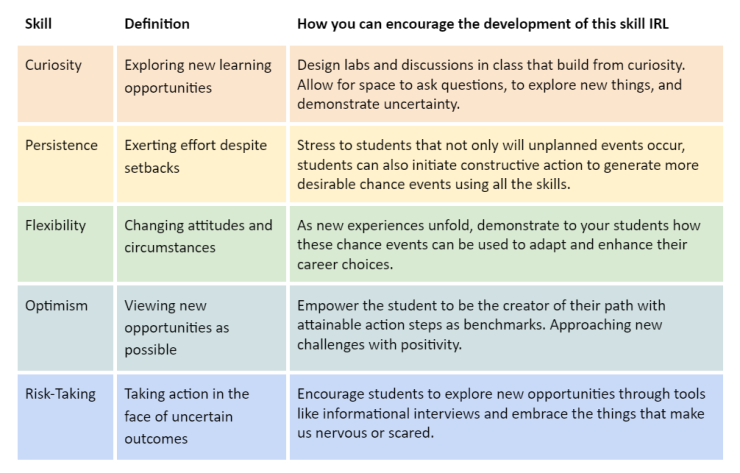Planned Happenstance in Career Exploration
By Amanda Amal Issa, CASE 2-Year College Director
What do you want to be when you grow up?
We’ve grown up being asked that question as early as Kindergarten and we continue to ask that of each other and ourselves throughout our years. From an early age we are conditioned to pick a title/career and focus solely on that career as we navigate our way through school choices, course options, and opportunities.
What if we take a moment to consider career exploration from a skills based mindset and create our own luck as we do it. Let’s briefly explore Planned Happenstance.
The purpose of happenstance is that you are not limited and you take action to remove the things that hinder you. There are two main considerations.
- Exploration generates chance opportunities for increasing quality of life
- Skills enable people to seize opportunities

The goal of planned happenstance intervention is to assist students to generate, recognize, and incorporate chance events into their career development.
Planned happenstance theory proposes that career counselors can assist students to develop five skills to recognize, create, and use chance as career opportunities. Identifying these five skills can support a person in recognizing their opportunities to create luck in their careers and personal growth. Understanding these skills can guide practitioners to create new approaches to student exploration and interests. It allows us to focus on skills development and attainment as students find their way into careers.

Below is a list of different areas of work and how components of each can be supported by Planned Happenstance.
Guided Pathways (Community Colleges)
- Guide undeclared students into areas of interest
- Discover unknown careers and explore career opportunities
- Map pathways through multiple career journeys
Career Pathways (K12)
- Focus on environment of industries and recognizing necessary skills
- Understanding skills as transferable and navigating careers
Counseling/Career Advising
- Shift focus from title of careers towards skills and interests
- Enhanced conversations with students to better understand interests
Teaching & Learning
- Embedding skills development in curriculum can equip students with tools for various careers
- Using the 5 skills of Planned Happenstance to support students in personal growth
Planned Happenstance is a chance to reflect on how one achieves their success and how to approach career mobility. It offers an alternative method to engaging students as they find their way towards a fulfilling life.
Reference: Mitchell, K.F., Levin, A.S. & Krumboltz, J.D. (1999). Planned happenstance: constructing unexpected career opportunities. Journal of Counseling & Development, 77(2), 115-124.
Amal Amanda Issa is a Regional Coordinator with the Foundation for California Community Colleges and adjunct faculty with Merritt College. She’s a secondary physical and biological sciences teacher as well as dual enrollment instructor. Amanda is CASE’s 2 year college director.







